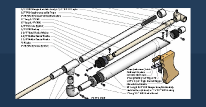To help get the idea of what this is, here’s a link to an LARGE cross section image of what this breech looks like. It’s pretty High res, or I’d just imbed it here.
This beautiful png right here!
The idea is that it’s a breech that can be used with high volume springers. I’ve been using 5” of 17/32” nested in PETG with amazing results in my xbow’s speedloader, but unfortunately with a breech you can’t really twist the dart in. So with 1” of unconstricted 9/16” before the 17/32” you can push the dart 1” into the 17/32” if you’re using shorter darts that 2” there could definitely be some adjustments made. If people are interested, I can make a plan like the above for 1.5” darts or whatever, just ask.
To make this, you will need:
A dremel – don’t even bother if you don’t have one
A rubber mallet – this is the only good way I’ve found to nest petg over 17/32” brass
Utility knife
Duct tape or painters tape
Sandpaper (I used 400 and 600 grit)
8.5” of PVC (not sure if it’s just my PVC, but 19/32” brass makes a perfect seal inside my pvc, this is important)
4.5” of 19/32” brass
4.5” of 9/16” brass
4” or 5” of 17/32 brass (it doesn’t really matter all that much, really)
A foot section of PETG (medium wall I think? Whatever.)
A small section (only like ¼”) of 3/8” brass
A single aluminum standoff, such as the kind used to make a +bow
JB weld glue or superglue
First off, you can prep your PVC for being breech-ified by cutting out a bit of duct tape to be the same size as the hole you want to have for the dart slot, in this case 2.5”x1.375”. then put it on the pvc exactly where the hole should be, 1” from the back in this case. Then outline it on the edge of the duct tape with a permanent marker, as pictured below. Then remove it, also pictured below. Use this marking as a guideline for dremeling a dart slot.


Then repeat that for where the bolt will be, as shown below, this time with the duct tape being .375” wide and 3.375” long.


Once this is cut, also use the sanding barrel of the dremel to make a point for the bolt to lock into at the back, as shown below. The thinner of the sanding barrels is close to 3/8”, which is a nice coincidence.You can sand down any sharp corners on the PVC a bit with the 400 grit sandpaper, but I suggest doing it by hand as any power sanding will take off way too much. What it should look like after all that:

Now, you want to take your 4.5” of 19/32” and use something like a ½” steel rod or drill bit to flare out one end just enough so that it fits perfectly in the pvc (assuming it doesn’t) and flare out the other side just a bit more, but not too much, put the less flared end into the back of the breech and lightly hammer it into the back of the breech until you have this:

Then do what you will with the dremel to cut that piece of brass into the same slot shape as the PVC it’s nested inside. Make sure to use some of that nice 400 grit sandpaper to take off the brass’s sharp edges on the inside, and finish it with the 600 grit if you have it.
Now you want to take your section of 17/32” brass, and nest it as much as you can by hand, and then stick it inside a longer section of pvc, vertically with the brass on the bottom as shown:

Then hit that bitch with your rubber mallet, figure a:

Swing your mallet hard, but carefully, and give it a solid hit. Doing this carefully is important, when you make contact make sure the mallet’s head is even on the top, if you hit the PETG on one side more than another, there’s a good possibility you’ll bend it real bad or crack it. Repeat the beatings until only 2.5” or so of the brass is exposed. Mark the PETG with a marker 3” up from the back of the brass. Also mark the 4.5” of 9/16” ½” from an edge, both pictured below.

Now comes some fun, you want to drill 2 tiny holes 1/8” apart at the 3” up mark on the PETG you just made, only you DON’T want to go into the 17/32”.Tthen use a utility knife to cut the long way around the PETG and down towards the brass so you have a 1/8” strip of just PETG, as always, as shown below. Throw away that piece of PETG, it’s not needed again.

Now drill 2 holes 1/8” apart like you just did on the PETG, but at that .5” mark on the 9/16”. Then use your dremel to cut it the same way as you cut the PETG. This piece of brass can also be discarded.

This is pretty much what it’s going to look like lined all up together right now. Also in this picture are the ¼” spacer you’re going to want, and the ¼” section of 3/8” brass. Both of those, it’s important to dremel down one side to have the same radius as the PETG (approximately, since that is what it gets glued to and you want them to be flush with the surface they’re being glued to).








































